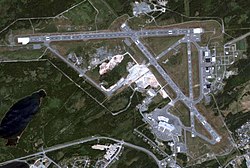St. John's International Airport
| St. John's St. John's International Airport |
|
|---|---|

|
|
| Characteristics | |
| ICAO code | CYYT |
| IATA code | YYT |
| Coordinates | |
| Height above MSL | 151 m (495 ft ) |
| Transport links | |
| Distance from the city center | 7 km northwest of St. John's |
| Street | Trans-Canada Highway |
| Local transport | bus |
| Basic data | |
| opening | December 15, 1941 |
| operator | St. John's Airport Authority |
| Terminals | 1 |
| Passengers | 1,600,000 (2016) |
| Runways | |
| 02/20 | 1533 m × 30 m asphalt |
| 11/29 | 2591 m × 61 m asphalt |
| 16/34 | 2135 m × 61 m asphalt |
The St. John's International Airport ( IATA code : YYT , ICAO code : CYYT ) is a commercial airport near the town of St. John's , Canada . It is part of the National Airport System . While the space shuttle was in operation, the airport was a possible emergency landing site in the event of an abortion.
history
The ideas for an airport near the city of St. John's in Newfoundland go back to 1939 when, after the outbreak of World War II, fear grew in Canada that German air force units might one day operate as far as Newfoundland. In response, consideration was given to building an airport that could have served as a base against a possible German invasion. After a decision was made in 1940, construction began in 1941.
On December 15, 1941, the Canadian Armed Forces officially opened the airport as Torbay Airport , after the closest location. As early as October 18, 1941, the first landings were made at the airport by three Boeing B-17s and one machine from the Canadian armed forces; At the end of October there was also an emergency landing of a B-24 bomber en route from Prestwick in Scotland to Gander . For the remainder of the war, the airport served as a transit station for American fighter jets en route to the European theater of war, for which the American armed forces permanently stationed personnel at the airport.
From April 1, 1946, the airport was officially used for civilian purposes, the military part continued to be operated as the Royal Canadian Air Force (RCAF) station Torbay , so that the Canadian Department of Transport (Ministry of Transport) was responsible for the operation. Shortly before, in March 1946, the control tower burned down , so until 1952 the air traffic controllers worked from a makeshift solution. Due to the presence of the American armed forces on the field in 1953, the Canadian armed forces again took over the management of the airfield and held it until April 1, 1964. At that time, the permanent presence of soldiers and military units at the airport was ended and it was again under put the control of the Ministry of Transport. The airport was renamed St. John's International Airport at the same time .
To improve comfort, an old terminal building from 1958 was replaced by a modern building in 1981, and a new control tower was put into operation as early as 1976. During the period before about 1990, when most commercial airliners were able to travel non-stop from Europe to the United States or Canada, the airport was used by airlines for refueling, although not to the same extent as the surrounding Gander and Halifax airports .
According to the airport, the number of passengers is currently around 1.5 million per year, and around 1,300 military aircraft movements are also handled.
The airport is equipped with an instrument landing system for runways 11, 16 and 29, the main runway 11/29 is equipped with high-performance approach lights of the type ALSF-2. There is also a VHF rotary radio beacon (VOR, identifier YYT ) and three non-directional radio beacons (NDB, identifiers NL , YT , ZNF ) for non-precision approaches.
Web links
- Official website of St. John's International Airport (English)
- Airport data from World Aero Data
- Airport data on Skyvector.com (English)
Individual evidence
- ^ North America Airport Rankings. (No longer available online.) ACI-NA.org , archived from the original on September 6, 2018 ; accessed on November 20, 2017 (English). Info: The archive link was inserted automatically and has not yet been checked. Please check the original and archive link according to the instructions and then remove this notice.
- ^ Justine Whitman: Space Shuttle Abort Modes. Aerospaceweb.org, June 25, 2006, accessed October 7, 2011 .
- ↑ a b c d e St John's Airport - History. In: St. John's Airport Authority. Retrieved April 19, 2016 .
- ^ AIP Canada. (PDF, 75 MB) In: Nav Canada, Department of Transportation. April 2016, p. 123 , accessed April 19, 2016 (English).
- ↑ Airport & FBO Info for CYYT. In: flplan.com. Retrieved April 19, 2016 .
